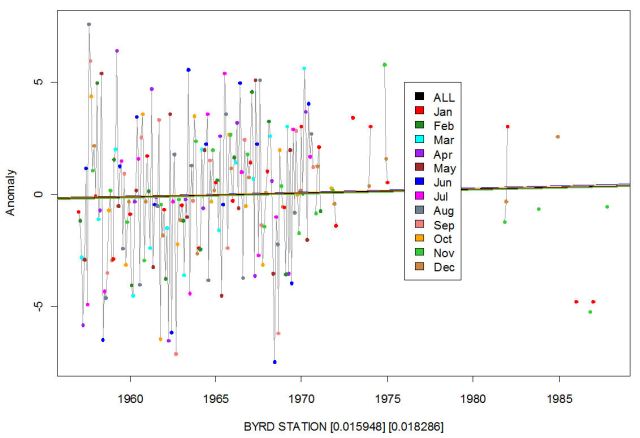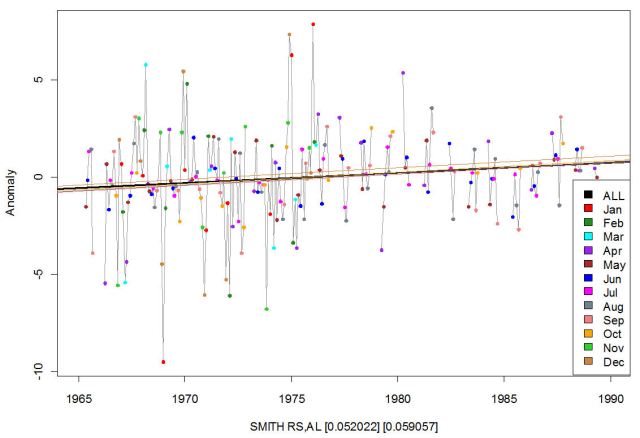(Post revised May 09, 2910: the simple linear regression line compared to Roman’s anomaly regression should of course have been fitted to the anomalies, not the raw data. Additional plots added. Must learn not to post in haste!)
At http://statpad.wordpress.com/2010/03/18/anomaly-regression-%E2%80%93-do-it-right/ RomanM discusses monthly anomaly regression, and when asked in comments whether he has tried this with the GISS data replied
GISS is left as an exercise for the reader. 😉
Nick Stokes in another comment cautions
Your example relates to taking a set of station values, computing an anomaly presumably by CAM, and then running a regression through the serial monthly anomalies for individual stations. But who does this? Not Gistemp – I don’t believe they compute trends anywhere, and they use a more complicated anomaly procedure.
This post is the first in a series attempting Roman’s exercise, and at the same time providing a detailed example of the GISTEMP anomaly and urban station adjustment procedures which may be useful for anyone who would like to learn more about these procedures, but does not have the time or inclination to wade through the FORTRAN code.
The series will include the following (and this table of contents will be updated as the relevant posts are added):
- Introduction: “my” GISTEMP and the station chosen for adjustment
- GISTEMP anomaly calculation
- GISTEMP rural station combination
- GISTEMP urban station adjustment
- GISTEMP anomaly calculation replaced by Roman’s Anomaly Regression
- The effect on the gridded results
(These posts will be based on the March Gistemp analysis. Identification of stations as rural or urban remains an issue while the coordinates in v2.inv remain suspect. An appropriate disclaimer should be assumed where adjusted or gridded results are shown)
First, a couple of comparisons for GISTEMP stations. These two were chosen as examples where the trends found were substantial, and where Roman’s procedure gives a noticeably different trend when compared to simple linear regression. Trends shown here are degrees C per year.

Byrd Station monthly anomalies. The heavy black line ("ALL") is the simple linear regression line, the other lines are fitted using Roman's procedure. 0.384843 is the trend from the simple linear regression line, 0.018286 the trend from Roman's procedure.
So using Roman’s procedure instead of the GISTEMP anomaly procedure (which is not the simple linear regression fit) could potentially produce different results. This will be explored in a later post in this series.
Revision: May 08, 2010. As can be seen below, where both a simple linear regression line and Roman’s anomaly regression are fitted to from the anomalies, the trend using Roman’s anomaly regression is unchanged, but the trend derived from the simple linear regression line is now quite similar to that derived by Roman’s anomaly regression.
- Byrd Station anomalies



Hi Peter,
Glad to see more from you. This is a great visual representation of the comparison. I’ve been hoping someone would have a go at station and box-level GISS data with Roman’s method. I’ve even wondered how long it would take me to learn enough R ‘from the basics up’.
I have been wading through notes on the GIStemp anomaly proceedure just in the last few days. Every time I revisit this area I become a little more sure of what the effects of the procedure are, and I am now eagerly anticipating what you have to say on it.
Peter O’Neill: This comment below is probably spam, and has been deleted as a posted comment, and the related url removed. Mail to webmaster@spottovo.ru fails, but if this is in fact a genuine comment, please post your actual question or provide a working e-mail address. (spottovo.ru appears to be a newly created site without content)
Hello! Please e-mail me your contacts. I have a question ……
Thank you!!!…